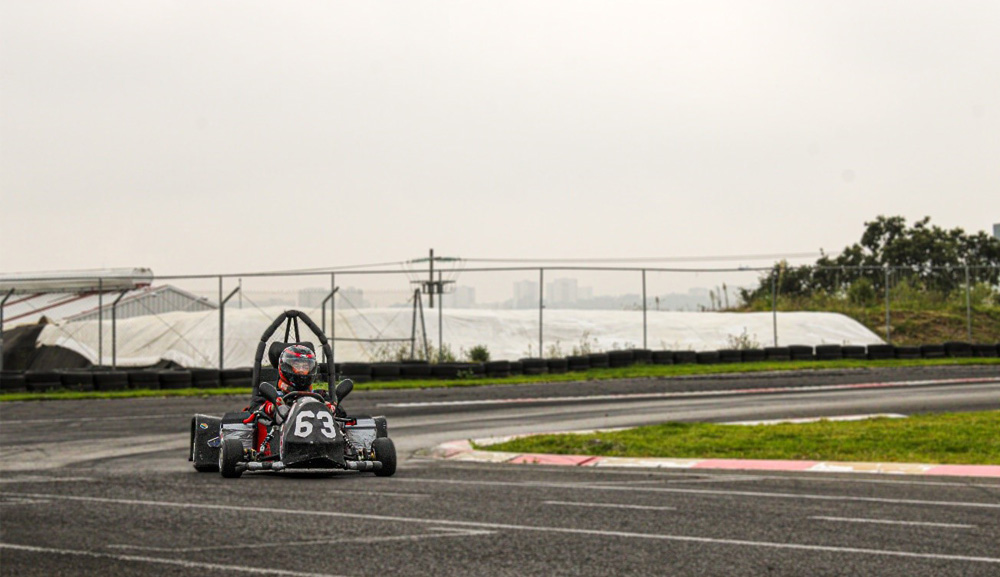Anahuac Racing Team: Accelerating into the future of electromobility

 Liderazgo Anáhuac en Innovación
Liderazgo Anáhuac en Innovación
The School of Engineering drives innovation in electric vehicles and promotes their technological development through the Mechatronics Engineering degree program and its team that participates in the Electratón Championship.
Electromobility is driving an unprecedented transformation in transportation, opening up a clear path to a more sustainable and efficient future. This development is key in the fight against climate change thanks to its ability to significantly reduce pollutant emissions. According to recent studies, electric vehicles can reduce greenhouse gas emissions by up to 43% compared to internal combustion vehicles, even when electricity generation is taken into account. Currently, sales of electric cars represent 7.6% of the national market, increasing by more than 3 percentage points compared to last year, 2023.
This phenomenon has gained momentum thanks to advances in key technologies such as batteries, motors and control systems. These breakthroughs, together with the implementation of public policies that promote the use of electric vehicles, have consolidated electromobility as a crucial trend that is transforming the automotive industry and stimulating the creation of sustainable infrastructures.
Meanwhile, international electric car competitions have accelerated this innovation by providing platforms for testing and refining technologies under high-performance conditions.
Internationally, Formula E is the benchmark for the development of electric technologies applied to motorsport, driving both innovation and sustainability in the global automotive industry. In Mexico, the Formula E-linked Electratón MX allows university students to participate in the design and manufacture of cutting-edge electric cars, with the goal of improving performance in competition and advancing the local automotive sector.
The 2022 edition of the Electratón Championship marked the return of this competition after two years of inactivity due to the COVID-19 pandemic. Throughout the season, the team representing Anahuac Mexico University faced various technical and logistical challenges, from problems with the chain cover to optimizing the battery change.
At the end of the season, the team held a feedback meeting where they agreed that each race had taught them something new, how to work under pressure, how to solve problems in real time and how to work as a real team, skills that cannot be taught in a classroom.
One of the most outstanding achievements was reducing the battery change time from 40 minutes to 2 minutes, a milestone that demonstrated the team's ability to innovate and adapt quickly to the circumstances.
The Anahuac Racing Team is preparing to face new challenges in the 2025 championship, including changes in the regulations that modify the permitted dimensions of the vehicles, so it plans to compete with a new aluminum vehicle equipped with LiFePO4 (lithium ferro-phosphate) batteries, replacing the traditional lead-acid batteries. This change will not only improve vehicle performance but will also represent a breakthrough in terms of sustainability, as these batteries are lighter, have a longer life and are safer for the environment.
In addition, the team will expand to participate in the SAE Baja competition, which will provide new opportunities to develop innovative electric mobility solutions.
Undoubtedly, participating in competitions such as the Electratón is not limited to the design and construction of single-seaters, as it also requires students to master a wide range of disciplines, from electrical and mechanical engineering to project management and effective communication; skills that are highly valued in today's job market, where versatility, adaptability and leadership are essential.
Based on all of the above, we can assure you that the Anahuac Racing Team is more than an engineering project; it is a comprehensive program that is educating the future leaders of the transition to electric mobility. It accelerates not only on the track, but also in technological innovation and sustainability, inspiring new generations to design and build the future of electromobility.
*With the collaboration of Dr. León Hamui Balas, Mechatronics Engineering Coordinator and Advisor to the Anahuac Racing Team; Ignacio Ferrer García, Laboratory Specialist and Advisor to the Anahuac Racing Team; and Rosa Citlali López Rivera, member of the Anahuac Racing Team and Mechatronics Engineering undergraduate student.
References:
Transport & Environment. (2020). How clean are electric cars? T&E's analysis of electric car lifecycle CO₂ emissions. https://www.transportenvironment.org/discover/how-clean-are-electric-cars/
Federal Government, Mexico City – Google Drive. (s. f.).
https://drive.google.com/drive/folders/1cFs7X_s0y94v6NuY_LVhMrC7h4cg6o3H
Del Arco, L. H. (2024, July 16). Así las ventas de coches híbridos y eléctricos en México. Diario AS. https://mexico.as.com/motor/asi-las-ventas-de-coches-hibridos-y-electricos-en-mexico-n/#:~:text=De%20esta%20cantidad%20de%20unidades,3%25%20en%20comparaci%C3%B3n%20con%202023.
For more information:
Dr. Leon Hamui
leon.hamui@anahuac.mx
School of Engineering
